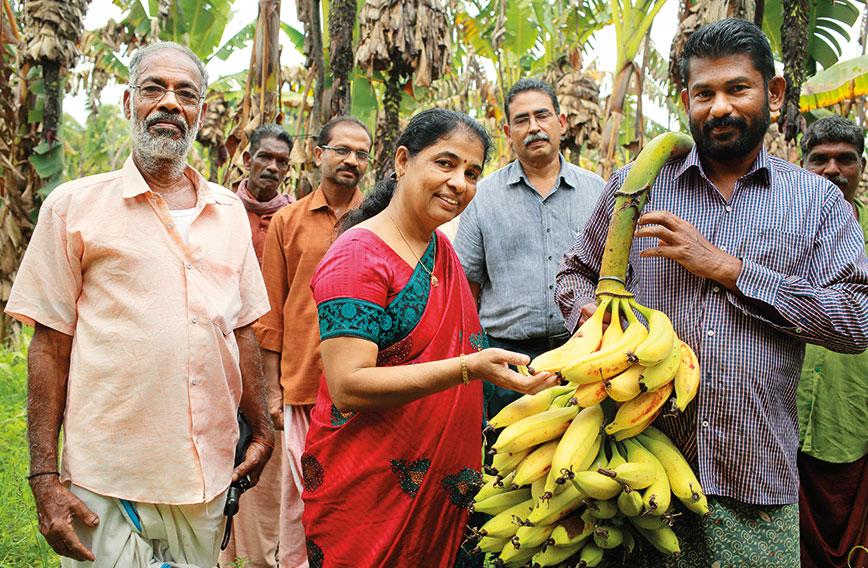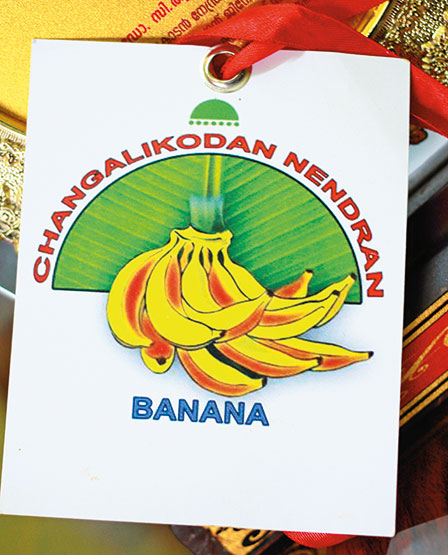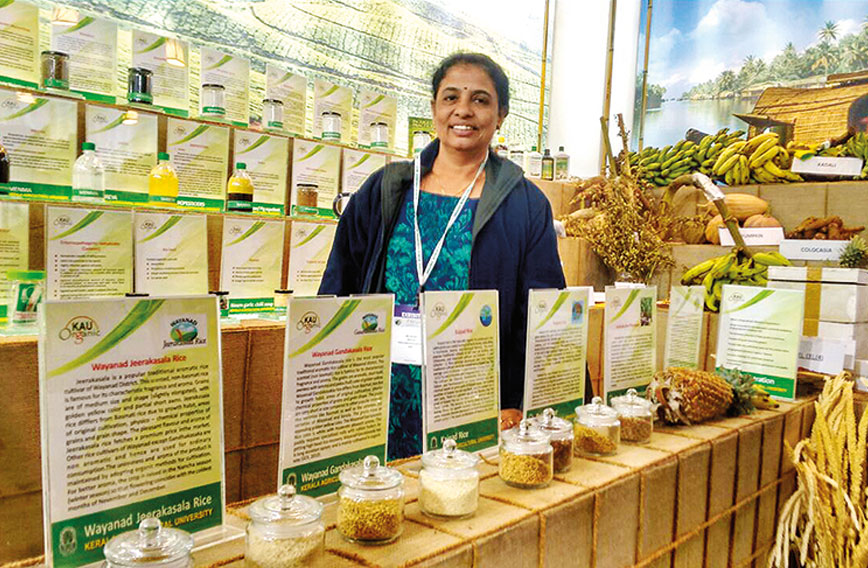
Dr Elsy with farmers who grow the Chengalikodan Nendran banana in Erumapetty
C.R. Elsy
Indian farmers are invariably at a disadvantage when it comes to protecting their intellectual property rights regarding their crops. They are simple folk, who don’t know where to begin.
But in Kerala, with Dr C.R. Elsy at hand, it has been much easier for several groups of farmers to assert themselves. Thanks to her efforts at the IPR Cell of the Kerala Agricultural University at Thrissur, eight crops now have Geographical Indication (GI).
The Chengalikodan banana is an example. It is a favourite during the Onam festival and is distinguished by its sweet taste and a red stripe on its skin. It was a well-known banana, but formal GI status puts it in another orbit altogether. To begin with, it sells for more and the growers have an identity that cannot be usurped.
Other crops that have got GI status are the Pokkali, Kaippad, Jeerakasala and Gandhakasala rice strains, the Vazhakulam pineapple, Travancore jaggery and Nilambur teak.
Before she retired recently, she had put another six products in line for GI status. They included the Kuttiyattoor mango, Marayoor jaggery and the Edayoor chilli.
Dr Elsy has shown how scientists need to go into the field and work with communities. She combined plant genetics with social activism in getting the farmers together and giving them an understanding of intellectual property laws.
Below is a piece that appeared in Civil Society's September-October 2018 edition. Read on.
The Intellectual Property Rights (IPR) Cell in Kerala Agricultural University (KAU) is sparse and innocuous but its outstanding work over the years has earned it an enviable reputation. Led by Dr C.R. Elsy, the IPR Cell, with a shoestring budget and a small team, has been scouting fields and farms in search of unique plant varieties which might otherwise have become extinct.
The cell has ensured that as many as eight such varieties now have Geographical Indication (GI), a recognition which raises the status of those crops and helps farmers earn more money.
 |
 |
 |
 |
The IPR Cell has submitted a GI application for Marayoor jaggery, noted for its sweetness and taste. Another six products are in the pipeline — the Kuttiyattoor mango, Tirur betel vine, Attappady Thuvara (red gram), Attappady Amara (Dolichos bean), Kodungallore pottu vellari (snap melon) and Edayoor chilly.There is Pokkali rice and Kaippad rice, which grow in a saline ecosystem, two fragrant rice varieties, Jeerakasala and Gandhakasala, the distinct Vazhakulam pineapple, the flavoursome Chengalikodan banana of the Nendran variety, Central Travancore jaggery and Nilambur teak.
Kerala is perhaps the only state in India that is tracking its unique varieties of crops and bringing them under IPR protection. Twenty-three crops now have the GI tag. Eight of those were identified by the IPR Cell.
Dr Elsy’s job is a demanding one. She has to detect the crop, study all its unique qualities, explain IPR protection to simple farmers and help them apply for GI recognition. The job means combining the science of plant genetics with human psychology and an understanding of IPR laws.
“We first inform locals that their community has a right over the product. We assure them that the university will support them if they want to protect it. Farmers, we find, are keen to protect their IPR. We advise them to form an association, which then applies for the GI tag. The IPR Cell only facilitates this process,” says Dr Elsy.
KAU started the IPR Cell in 2001. The Vice Chancellor of KAU, Dr R. Chandra Babu, is the chairperson of the IPR Cell and scientists from different faculties are its members.
What impact does IPR protection have on a crop? To find out we travel 45 minutes by road from Thrissur to Erumapetty, home of the famed Chengalikodan banana which now has a GI tag thanks to Dr Elsy and her team.
Kerala’s native Nendran banana is a familiar household fruit. But the Chengalikodan variant of the Nendran, distinguished by a red stripe on its skin, though traditonally favoured, lacked GI status.
“It is a unique banana, sweeter than other Nendran varieties and quite different in looks and properties,” says P.V. Sulochana, a retired agriculture officer who served Erumapetty panchayat for 15 years.
 Banana farmers plant the Chengalikodan so that its harvesting time synchronises with the onset of the Onam festival. We find farmers here in a cheerful mood.
Banana farmers plant the Chengalikodan so that its harvesting time synchronises with the onset of the Onam festival. We find farmers here in a cheerful mood.
“Thanks to the GI tag, the Chengalikodan banana is now known all over Kerala. Demand for our bananas has gone up. A lot of people come here to buy them,” says A.V. Johnson, secretary of the Chengalikodan Banana Growers Association. The media, both print and television, also spread news of Chengalikodan’s newly acquired GI status.
The Chengalikodan is grown on about 2,000 hectares of Thrissur district and demand now outstrips supply. Customers specifically ask for this banana. Last year, the ordinary Nendran was selling for Rs 100 per kg. The Chengalikodan, on the other hand, was priced at Rs 130. When the Chengalikodan banana didn't have GI status the difference between the two was nominal. So farmers now earn much more.
They have also got together and formed the Chengalikodan Banana Growers' Association. They pooled Rs 10 lakh and invested in a small building which now serves as an office. This year, the association is planning to sell bunches of Chengalikodan from their newly acquired premises. “In the long term we plan to do some value addition and sell packaged Chengalikodan products from here,” says N.K. Vijayan, Vice-President of the Association.
Marayoor jaggery hasn’t as yet received its GI tag but word has spread via the media. Farmers say the number of trade enquiries they receive has gone up this year. The jaggery is produced in the high ranges of Idukki district. But the downside is that farmers don’t have the expertise to cater to a bigger market. They are posting small parcels of jaggery to interested customers. Agriculture Minister V.S. Sunil Kumar has promised the government will help them improve their marketing skills.
Dr Elsy has built the IPR Cell from scratch. When it started, it had no computers, assistants or infrastructure. Dr Elsy, then a ‘coordinator’, didn’t know where to begin. But over the years she has mastered all the nuances of IPR and her cell now files applications minus any assistance from costly lawyers.
Dr Elsy is, actually, a rice breeder. She did her PhD from Tamil Nadu Agriculture University (TNAU) in hybrid rice breeding. Her guide was Dr M. Rangaswamy, then Director, School of Genetics. He once asked her to do a presentation on IPR, she recalls, and that stood her in good stead when she was put in charge of the IPR Cell in KAU. For a while, Dr Elsy taught and did research. She became head of the plant breeding department in KAU. In 1999, the Kerala government gave her the Young Scientist award.
 A range of crops now have the GI tag
A range of crops now have the GI tag
In the initial stages the IPR Cell couldn’t make much headway. Dr Elsy started reading on the subject and attending seminars. She read about Darjeeling tea and how it got a GI tag in 2004. It struck her that Kerala was blessed with so much biodiversity. Why couldn’t the IPR Cell identify unique varieties and get them IPR protection, she thought.
The first crop she selected for filing a GI application for was Pokkali rice. The cell undertook the fieldwork and the scientific evaluation. For drafting the application, it approached a lawyer. He asked for `60,000 as his fee. Dr Elsy was shocked.
“Farmers can’t afford to pay that much,” Dr Elsy recalls, “Neither could the university. We had all the information. All we needed was a lawyer to draft the application.”
The dedicated professor didn’t give up. She bought a copy of the IPR Act and studied it closely. She had friends who had worked with the GI Registry. She talked to them and to a few friendly lawyers. In about a year Dr Elsy understood all the procedures. She began drafting and redrafting her first GI application with all the passion of a poet writing his first poem.
The GI registration process is a long one and takes about a year. After the IPR Cell has identified and validated a unique crop variety, it holds a public meeting in the village, however far away, with all stakeholders. The first step is to get IPR protection and the GI tag. The second is to help farmers use this new recognition to market their crop and get better prices.
Dr Elsy explains in simple terms why IPR is essential for farmers. “It’s like your landed property. If you don’t put a fence around it, someone can encroach on it. Throwing them out after that will be a big headache. Secondly, you can use the GI tag to augment your income. If you plan properly, you can get a higher price. You can also prevent others from using the name of your product.”
Another sensitive issue that crops up is whether the identified variety should be registered in an individual farmer’s name when it is being grown by an entire community in several villages.
The cell takes all stakeholders into confidence. The main problem that arises is identifying the areas the GI should cover. The cell liaises with the Principal Agriculture Officers (PAOs) in the agriculture department. Agriculture minister Sunil Kumar is also well versed in IPR and gets involved.
“His suggestions are mature and always in the larger interest of communities. He believes that farmers shouldn’t insist that the GI be limited to one area. It should be fair to all areas,” says Dr Elsy.
She handholds farmers through the entire process. For example, take logos. The GI Registry accepts applications even without logos. But Dr Elsy takes the trouble to get a well-designed logo and she files it along with the application. All eight crop varieties that got GI recognition through the IPR Cell have their own logos.
For Marayoor jaggery, the cell even organised a logo-designing competition. A press release was issued and the media publicised it. This strategy also helps the product acquire a distinct image. For the Marayoor jaggery logo, the cell received 87 designs.
When the cell started, members of KAU’s faculty questioned whether it was the university’s job to get GI tags for farming communities. They didn’t think a professor’s valuable time should be spent on such an exercise. “Gradually, they began understanding why we should get involved. We now get financial support from KAU and the state government,” says Dr Elsy.
 Dr Elsy with her assistants in the IPR Cell
Dr Elsy with her assistants in the IPR Cell
The turning point for the IPR Cell’s fortunes came in 2013, after it had already shown its worth. By then it had got GI for five products and 12 Plant Genome Saviour awards, given to farming communities, farmers and breeders who are conserving and propagating unique plant varieties.
Dr Elsy was invited to make a presentation at a high-profile meeting in Thiruvananthapuram. She proposed a ‘Centre for Intellectual Property Rights’ (CIPR) be set up to vet IPR applications from other agencies and see them through.
Subrata Biswas, the agricultural production commissioner, was very impressed and he immediately promised to sanction Rs 25 lakh for setting up the centre. The IPR Cell started getting more government funding. The CIPR was set up for a year. A fresh proposal is made each year. The CIPR complements the objectives of the IPR Cell but is wholly funded by the state. The agriculture department also uses it for GI registration.
Dr Elsy not only handles the cell but is also continuing her work as a rice breeder. This year KAU released Manu Rathna, a new rice variety.
The IPR Cell has also succeeded in getting 18 Plant Genome Saviour (PGS) Awards which are given by the Protection of Plant Varieties and Farmers’ Rights Authority. This year, the cell has sent 11 nominations for the PGS awards. This is the highest number of nominations the IPR Cell has ever made.
Once the awardees are announced, a ceremony is held — generally in New Delhi. The problem is that Dr Elsy is informed just a week in advance. Getting train tickets at the last minute is a Herculean effort.
The organisers pay for an air ticket for Dr Elsy and second-class train travel for the awardees. The farmers can’t travel alone because they don’t know Hindi. So Dr Elsy travels with them. “Even if they reach New Delhi railway station, they won’t be able to find the venue on their own,” she says with concern. Despite her best efforts, things haven’t changed in the past six years.
She recalls the advice Dr Rangaswamy, her teacher, gave her when she was leaving TNAU. “Do something good for farmers. You can’t help them by working out of an air-conditioned room. Go to their farms, understand their problems.” Dr Elsy conveys the same advice to her own students: “There are many farmers who don’t know about the plant genome awards. Help them.”
 The IPR Cell plans to make short documentaries on each of the GI products it got registered. A film on the Chengalikodan banana has already been made. “Such films will help us give a proper picture of the variety to the consultative committee that assesses the product,” explains Dr Elsy. Farmers can use the film for popularising the crop after it has received the GI. Dr Elsy hopes the documentaries will be seen by students and motivate them to help farmer groups to protect their unique varieties and get IPR.
The IPR Cell plans to make short documentaries on each of the GI products it got registered. A film on the Chengalikodan banana has already been made. “Such films will help us give a proper picture of the variety to the consultative committee that assesses the product,” explains Dr Elsy. Farmers can use the film for popularising the crop after it has received the GI. Dr Elsy hopes the documentaries will be seen by students and motivate them to help farmer groups to protect their unique varieties and get IPR.
For the past six years, the IPR law and the GI process are also being taught at KAU. “One question which is always put to students is, how will you file an application for a unique variety at the GI registry? This question prompts students to understand the procedures involved,” says Dr Elsy.
Dr Elsy’s work has brought her recognition. KAU was recently awarded as the ‘best institution in GI facilitation and registration 2018’ by the Union ministry of commerce and industry.
Cheruvayal Raman of Wayanad has conserved 45 varieties of rice. He is a past winner of the Plant Genome Award. A poor farmer, he lives in a mud hut. “Imagine the time and money he must have spent to conserve so many rice varieties. When I meet such unassuming achievers, I feel very happy that I helped to get them recognition at a national level,” says the earnest Dr Elsy.
Shree Padre travelled with Lakshman Anand to Erumapetty and Thrissur for this piece
Comments
Currently there are no Comments. Be first to write a comment!



